Predictive models for musculoskeletal injury risk: why statistical approach makes all the difference
- PMID: 36268503
- PMCID: PMC9577931
- DOI: 10.1136/bmjsem-2022-001388
Predictive models for musculoskeletal injury risk: why statistical approach makes all the difference
Abstract
Objective: Compare performance between an injury prediction model categorising predictors and one that did not and compare a selection of predictors based on univariate significance versus assessing non-linear relationships.
Methods: Validation and replication of a previously developed injury prediction model in a cohort of 1466 service members followed for 1 year after physical performance, medical history and sociodemographic variables were collected. The original model dichotomised 11 predictors. The second model (M2) kept predictors continuous but assumed linearity and the third model (M3) conducted non-linear transformations. The fourth model (M4) chose predictors the proper way (clinical reasoning and supporting evidence). Model performance was assessed with R2, calibration in the large, calibration slope and discrimination. Decision curve analyses were performed with risk thresholds from 0.25 to 0.50.
Results: 478 personnel sustained an injury. The original model demonstrated poorer R2 (original:0.07; M2:0.63; M3:0.64; M4:0.08), calibration in the large (original:-0.11 (95% CI -0.22 to 0.00); M2: -0.02 (95% CI -0.17 to 0.13); M3:0.03 (95% CI -0.13 to 0.19); M4: -0.13 (95% CI -0.25 to -0.01)), calibration slope (original:0.84 (95% CI 0.61 to 1.07); M2:0.97 (95% CI 0.86 to 1.08); M3:0.90 (95% CI 0.75 to 1.05); M4: 081 (95% CI 0.59 to 1.03) and discrimination (original:0.63 (95% CI 0.60 to 0.66); M2:0.90 (95% CI 0.88 to 0.92); M3:0.90 (95% CI 0.88 to 0.92); M4: 0.63 (95% CI 0.60 to 0.66)). At 0.25 injury risk, M2 and M3 demonstrated a 0.43 net benefit improvement. At 0.50 injury risk, M2 and M3 demonstrated a 0.33 net benefit improvement compared with the original model.
Conclusion: Model performance was substantially worse in the models with dichotomised variables. This highlights the need to follow established recommendations when developing prediction models.
Keywords: Injury; Neuromuscular; Prevention; Risk factor.
© Author(s) (or their employer(s)) 2022. Re-use permitted under CC BY-NC. No commercial re-use. See rights and permissions. Published by BMJ.
Conflict of interest statement
Competing interests: None declared.
Figures
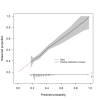
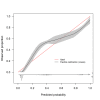
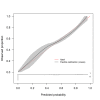
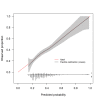
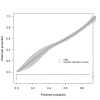
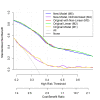

Similar articles
-
[Effects of induced hypertension on brain compliance and perfusion pressure in experimental intracranial hypertension: comparison between cryogenic brain injury and subdural balloon].Rev Bras Anestesiol. 2005 Jun;55(3):289-307. doi: 10.1590/s0034-70942005000300006. Rev Bras Anestesiol. 2005. PMID: 19471834 Portuguese.
-
How Does the Skeletal Oncology Research Group Algorithm's Prediction of 5-year Survival in Patients with Chondrosarcoma Perform on International Validation?Clin Orthop Relat Res. 2020 Oct;478(10):2300-2308. doi: 10.1097/CORR.0000000000001305. Clin Orthop Relat Res. 2020. PMID: 32433107 Free PMC article.
-
Enhancing the prediction of acute kidney injury risk after percutaneous coronary intervention using machine learning techniques: A retrospective cohort study.PLoS Med. 2018 Nov 27;15(11):e1002703. doi: 10.1371/journal.pmed.1002703. eCollection 2018 Nov. PLoS Med. 2018. PMID: 30481186 Free PMC article.
-
A study on the association of cytochrome-P450 1A1 polymorphism and breast cancer risk in north Indian women.Breast Cancer Res Treat. 2007 Jan;101(1):73-81. doi: 10.1007/s10549-006-9264-2. Epub 2006 Jun 29. Breast Cancer Res Treat. 2007. PMID: 16807674
-
Much work remains to reach consensus on musculoskeletal injury risk in military service members: A systematic review with meta-analysis.Eur J Sport Sci. 2022 Jan;22(1):16-34. doi: 10.1080/17461391.2021.1931464. Epub 2021 Jun 18. Eur J Sport Sci. 2022. PMID: 33993835
Cited by
-
Model for Musculoskeletal Injury Risk Factors Among US Army Basic Combat Trainees.JAMA Netw Open. 2025 Jun 2;8(6):e2513177. doi: 10.1001/jamanetworkopen.2025.13177. JAMA Netw Open. 2025. PMID: 40455447 Free PMC article.
-
Limitations of Separating Athletes into High or Low-Risk Groups based on a Cut-Off. A Clinical Commentary.Int J Sports Phys Ther. 2024 Sep 1;19(9):1151-1164. doi: 10.26603/001c.122644. eCollection 2024. Int J Sports Phys Ther. 2024. PMID: 39229450 Free PMC article.
-
Developing clinical prediction models: a step-by-step guide.BMJ. 2024 Sep 3;386:e078276. doi: 10.1136/bmj-2023-078276. BMJ. 2024. PMID: 39227063 Free PMC article.
-
Musculoskeletal Injury Risk Stratification: A Traffic Light System for Military Service Members.Healthcare (Basel). 2023 Jun 7;11(12):1675. doi: 10.3390/healthcare11121675. Healthcare (Basel). 2023. PMID: 37372795 Free PMC article.
-
A machine learning framework to classify musculoskeletal injury risk groups in military service members.Front Artif Intell. 2024 Jun 19;7:1420210. doi: 10.3389/frai.2024.1420210. eCollection 2024. Front Artif Intell. 2024. PMID: 39149163 Free PMC article.
References
LinkOut - more resources
Full Text Sources
